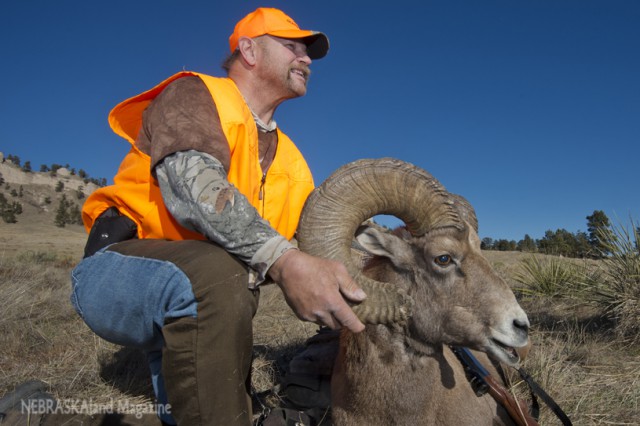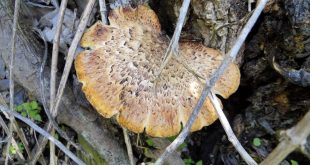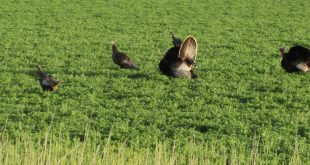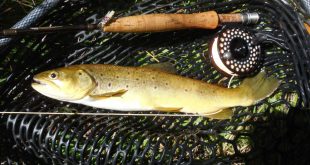
CRAWFORD – In order to find success, one hunter this week made the 430-mile journey from Western, Nebraska, to Western Nebraska. Yes, you read that right.
Johnny Barta, a big game hunter from Western, Nebraska (the village near Fairbury, not the region), visited the butte country of western Nebraska (the region, not the village) to fill the state’s lone bighorn sheep tag. His hunt ended successfully at noon Tuesday, Dec. 9, when he bagged a trophy ram at Fort Robinson State Park.
Barta won the permit by lottery earlier this year when his name was drawn from about 1,200 applicants who paid $25 each. Barta was joined on the hunt by his adult son Justin of Lincoln, as well as Nebraska Game and Parks Commission staff. In addition to guides, the deal included food and lodging from Fort Robinson State Park.
The hunt began at sunrise Monday, and the group spent most of that day looking for sheep and finding the big rams. It was a better-than-average day for finding bighorns, said the Game and Parks staff members who observe sheep daily.
Todd Nordeen, who manages the bighorn sheep program for Game and Parks and guided the hunt, said the sheep at Fort Robinson are the state’s oldest and have the most trophy caliber rams. The 12-year-old ram taken by Barta was the 18th harvested in the history of Nebraska’s reintroduction program, which began in the 1980s and has grown to about 350 sheep in four areas of the Panhandle. This was the state’s first hunt since 2012.
“We were fortunate to have several trophy-sized rams at Fort Robinson this year to allow a quality hunt,” Nordeen said. “We were able to see a lot of sheep in the past two days and were greeted with beautiful weather.”
Both days were unseasonably warm with highs in the 50s and light winds. The group spent most of Monday scouting and spotted several groups of sheep at the 22,000-acre park.
When Tuesday morning came, Barta decided pursue one particular ram, perhaps the biggest in the area, spotted the previous day near the eastern edge of the picturesque Red Cloud Buttes.
As the hunting party traveled by truck eastward on U.S. Highway 20 that morning, they again spotted sheep on the south side of the buttes. A look through the spotting scope affirmed suspicions that the big male was tending to the herd.
With the sheep near the buttes and wind from the west, Barta and his team decided to hike around the back side of the buttes and approach the herd from the north. In the time it took the group to crest the buttes from that direction, though, the sheep had moved southward away from the distinguished rock formations. From the hunters’ post high above the park, the herd was spotted far away near a pair of drainages leading away from the buttes. Rather than wait for the sheep to return to the buttes, Barta and crew decided to instead backtrack and approach the herd from the south.
One of the ravines, lined with ponderosa pines, provided the cover they needed to get within shooting distance of the herd. After trekking back around the buttes, they walked the bottom of the ravine. Nearing the herd, Barta and Nordeen climbed out of the drainage to get a vantage point. At about a football field’s length stood the ram, along with a few younger male contenders and about a half-dozen ewes.
As Barta was crawling to get his .30-06 rifle in place for the shot, the healthy ram was preoccupied. He butted heads twice with a younger male who was vying for dominance. Several minutes passed until a shot opened up. Under the midday sun, Barta took the 110-yard shot and hit the big ram behind the shoulder. A second shot ensured its quick death.
Although the ram’s horns had been considerably worn from wear, they exceeded a three-quarters curl and registered an unofficial score of 168 5/8 – an excellent trophy by any state’s standards. Nordeen noted that teeth of the ram also were showing heavy wear, a sign that it wouldn’t have been long before his health began to decline.
Barta said the hunt was a great experience and a good way to promote the state’s program to reintroduce a species that was extirpated in the early 1900s during European settlement. He also said it was an invaluable father-son experience.
“A highlight was being out here seeing these buttes with my son because he’s never been here before,” Barta said. “We had a good hike this morning and got to see things most people don’t get to see.”
Game and Parks commissioners have approved two licenses for 2015. One will be awarded by lottery and another by auction. Proceeds from the permits go toward the agency’s conservation efforts for the species.
 Nebraskaland Magazine
Nebraskaland Magazine



